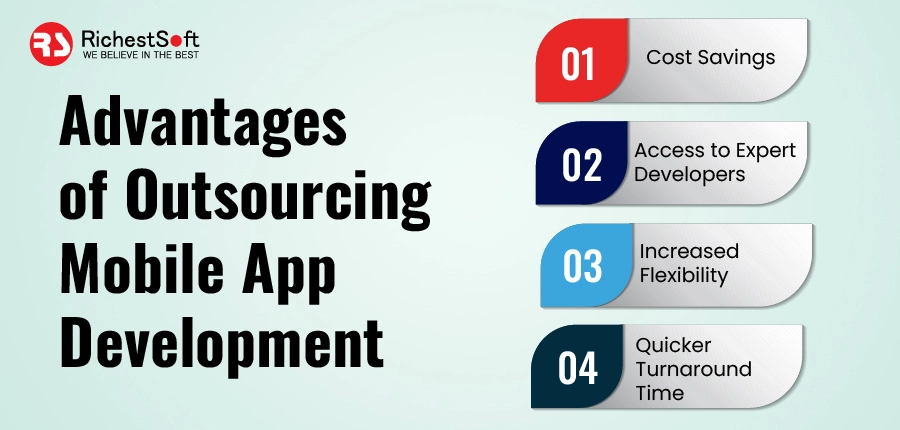In the modern world, e-learning has become an increasingly popular alternative to traditional classroom-based education. With the advancement of technology and the internet, individuals and organizations can access a wealth of knowledge and skills from the comfort of their homes. In this article, we will outline the key steps and considerations involved in developing an effective e-learning application. Let us start with this E-Learning App Development Guide.
Creating Engaging Educational Apps:
E-learning is a form of education that utilizes electronic technologies to deliver learning content and facilitate interaction between learners and educators. This can include online courses, virtual classrooms, video lectures, and various other digital resources.
Benefits of Developing an E-learning App
In today’s fast-paced world, where technology has become an integral part of our lives, the use of e-learning apps has gained immense popularity among learners.
1. Flexibility:
One of the major benefits of using an e-learning app is that it offers a flexible and convenient way of learning. With the help of e-learning apps, learners can access educational content from anywhere and at any time. This provides learners with the flexibility to learn at their own pace, and at a time that is convenient for them.
2. Level of Interactivity:
Another significant benefit of using an e-learning app is the level of interactivity it offers. E-learning apps come equipped with a range of features such as videos, quizzes, games, and simulations that facilitate an engaging and interactive learning experience. The use of multimedia elements like images, audio, and video aids in the retention of knowledge and provides a better understanding of complex concepts.
3. Cost-Effective:
E-learning apps are also cost-effective and comparatively cheaper than traditional learning methods, which require expensive textbooks and other resources, e-learning apps are designed to provide quality education to learners everywhere, irrespective of their financial backgrounds.
The use of E-learning apps promotes self-paced learning, which further aids in the development of essential skills like time management, goal setting, and self-discipline. Given the flexible nature of E-learning apps, learners can schedule their learning at their convenience and take as much time as required to understand the topic without any pressure.
The use of E-learning applications also empowers learners and progress which is an important skill to have in today’s competitive world.
Step to Building an Educational App:
Now let us discuss the educational app requirements required to build e-learning applications.
1. Understanding the target audience:
Before developing an e-learning app, it is important to understand who the target audience is. This can include students of a particular age group, professionals in a specific industry, or learners with a certain level of educational background. It is essential to identify the target audience’s learning preferences and styles.
Furthermore, creating personas is a useful technique for developing a clear understanding of the target audience. By creating personas, developers can ensure that the e-learning application is tailored to the needs of the target audience.
2. Designing the User interface and User Experience:
- User interface design principles: Designing a user interface that is both functional and visually appealing is crucial for the success of an e-learning application. User interface design principles such as simplicity, consistency, and ease of navigation should be followed to ensure a positive user experience.
- Creating a logical Flow: A logical flow is essential in an e-learning application, as it helps learners navigate through the course material efficiently. Each module should be designed to build upon the previous one, creating a smooth and logical progression.
- Wireframing and Prototyping: Wireframing and prototyping can be used to test the user interface design before implementation. These techniques allow developers to identify potential usability issues, refine the design, and ensure that the application is user-friendly.
- Testing and Quality Assurance: Testing and quality assurance are critical components of developing any software application, including e-learning applications. This section covers some of the key considerations that must be addressed to ensure that your e-learning application meets the highest quality standards.
3. Developing an E-learning Application:
The development of an E-learning app is a complex process that requires a clear understanding of the target audience and a well-formulated development strategy. The first step in the development of an E-learning app is to define a clear set of goals for the app. These goals should include what type of educational content will be included in the app, the target audience, and the features and functionality that will be offered. Once the app’s goals are defined, the next step is to create a project outline that includes a development timeline, a budget, and a list of resources required.
The development team for the E-learning app should then begin to work on the design and development of the app. This involves creating a user interface that is intuitive and easy to use, as well as designing the educational content that will be included in the app. The team should also work on integrating any necessary third-party tools and technologies, such as a learning management system, into the app.
Tech Stack for Creating E-learning Applications:
- Java: It is a multi-platform, object-oriented programming language. It is fast, scalable, and reliable.
- Kotlin: It is another general-purpose development language, free, and open source.
- C#: C# is one of the easiest programming languages for developers to develop an E-learning application.
- Python: It is an interpreted programming language and has a vast community of active users.
- MySQL: It is one of the most popular databases because it provides comprehensive support to develop several types of apps.
- PostgreSQL: This database is best suited for complex queries or data analysis warehousing, etc.
- MongoDB: This database is best suited for unstructured data.
- Oracle: It has flexible standards and offers high performance, scalability, and is easily programmable.
4. Creating a Test Plan
Creating a test plan is an essential step that involves identifying the key areas that need to be tested and defining the testing procedures that will be used to evaluate the application’s functionality, usability, and performance.
i. Conducting user acceptance testing
Conducting user acceptance testing involves working with a group of test users to evaluate the application’s functionality and features from a user’s perspective. This testing process can help identify areas that need improvement and provide valuable feedback that can be used to refine and improve the application.
ii. Ensuring Accessibility and Usability
Ensuring that your e-learning application is accessible and user-friendly is essential to creating a positive learning experience for your students. This includes testing the application’s functionality on different devices and platforms to make sure that it is accessible to a wide range of users.
5. Launching and marketing the E-learning Application:
Once your e-learning application is developed and tested, it is time to launch and promote it to your target audience. This section covers some of the key strategies that can be used to effectively launch and market your e-learning application.
i. Choosing a launch strategy
Choosing the right launch strategy can significantly impact the success of your e-learning application. This includes identifying the target audience, defining the launch message, and selecting the right channels to promote your application.
ii. Creating a Marketing Plan:
Creating a marketing plan involves developing a set of strategies and tactics that can be used to promote your e-learning application to your target audience. This includes identifying the most effective marketing channels, creating engaging marketing materials, and developing a plan to measure the success of your marketing efforts.
6. Measuring the Success of the Launch
Measuring the success of your e-learning application’s launch involves tracking various metrics such as user engagement, retention, and satisfaction. This information can be used to identify areas that need improvement and refine your marketing and promotional strategies to maximize the application’s potential.
i. Analyzing performance:
Analyzing Performance and refining the application is an ongoing process that involves monitoring user behavior, collecting feedback, and making continuous improvements to the application’s features and functionality.
ii. Tracking User Progress and Performance:
It involves evaluating the application’s effectiveness in delivering learning outcomes and identifying areas that need improvement. This includes tracking user engagement, assessment scores, and completion rates.
iii. Collecting user Feedback:
Collecting user feedback is a valuable source of information that can be used to identify areas that need improvement and refine the application’s features and functionality. This includes conducting surveys, interviews, and focus groups to gather feedback from users.
7. Iterating and Improving the Application:
Iterating and improving the application involves using the data and feedback collected to make continuous improvements to the application’s features and functionality. This process involves prioritizing the most critical areas that need improvement and making incremental changes to improve the application’s overall effectiveness and user experience. Developing Educational App Solutions can be a complex process, but with careful planning and execution, it can lead to a valuable and successful learning tool.
By following the steps and considerations outlined in this blog, you can create an application that is effective, and accessible to a wide range of learners. Remember to constantly analyze and refine your application based on user feedback and performance metrics. With dedication and effort, you can create an e-learning application that meets the needs and expectations of your target audience.
How and E-learning Applications work?
Custom e-Learning Solutions have revolutionized the way education is delivered to learners. These apps use advanced technologies in Android and iOS application development to provide learners with a personalized learning experience. The working mechanism of e-learning apps involves several processes.
- Firstly, the app collects data about the learner’s skill level and learning preferences using the assessment test. This data is then analyzed to create a customized learning path for each user, based on their strengths and weaknesses. Once the personalized learning path is created, the app delivers content to learners through various formats such as video lectures, simulations, quizzes, games, and interactive assessments.
- Secondly, the app is designed to track the learner’s progress at every step and provide immediate feedback. This feedback helps learners to identify their areas of improvement and modify their learning path accordingly. The app also uses AI-powered algorithms to adjust the difficulty level of the content, based on the learner’s performance.
- Finally, e-learning apps provide learners with social and collaborative learning opportunities. Users can join discussion forums, share their knowledge, and collaborate with other learners to solve problems. This feature enhances the learning experience and helps users retain the knowledge gained through the app. E-learning apps have transformed the traditional mode of education by providing personalized, interactive, and collaborative learning experiences. The working mechanism of e-learning apps includes several processes, which enable learners to learn at their own pace, track their progress, and collaborate with peers, all in a single platform.
Also Read: Key Differences Between Android And iOS App Development
Features for E-Learning Apps
The increase in educational technology has impacted E-learning positively, with students and educators seeking online learning opportunities. Thus, e-learning app developers need to understand the critical features and advantages of successful e-learning apps to enable students to learn easily and educators to deliver instructions conveniently. These features will help create an interactive and engaging learning experience for students.
1. Easy to Navigate:
Firstly, successful e-learning apps should be user-friendly and easy to navigate. The app design should be simple and intuitive, allowing students to understand the interface in a few minutes. Information access and the course design should be straightforward, and all basic functionalities should be presented clearly. The learning materials should be well-organized and divided into sections for easy browsing, and there should be efficient search tools to enable students to find the information they need quickly. Easy-to-use e-learning apps have a higher probability of attracting students and gaining traction.
2. Interactive:
Secondly, for an e-learning app to be considered successful, it must be interactive with multimedia features such as videos, images, and audio. The addition of multimedia to an e-learning app can help students who find it difficult to learn from traditional textbook methods to comprehend better. A well-produced multimedia learning experience can make the learning materials more interesting and engaging, thus leading to increased student participation and learner achievement. Effective multimedia encourages interactivity and helps students to retain information more quickly.
3. New Features:
Thirdly, successful e-learning apps must provide the opportunity for online assessments to check the student’s performance. Through feedback and grading, students will have a clear understanding of their progress, strengths, and weaknesses. Practicing for assessments can also help students in the future build their learning habits, leading to better results. An assessment feature that is well integrated into the e-learning app will engage students and encourage them to continue learning.
4. Accessibility:
Lastly, a successful e-learning app should be offered on different platforms to attract more students. E-learning apps that are available on several platforms, including mobile applications, desktop, and tablet versions, will attract more students. The availability of an e-learning app across multiple platforms means that it will be accessible to students who prefer learning on multiple devices.
Successful e-learning apps must incorporate user-friendly features, be interactive, have features such as assessments, and be available on different platforms. E-learning apps designed with these features in mind will foster student participation, retain users’ interests, and provide a better and more effective learning experience. Successful e-learning apps can lead to student achievements, increase learning outcomes, and pave the way for the growth of remote learning.
What are the Different Types of E-learning Apps?
E-learning has become a popular app development trend in the educational sector. Due to technological advancements, learning is now easier than before. In recent years, there has been a rapid expansion in the usage of e-learning apps to access educational materials. Several types of e-learning apps are used for different academic purposes. These include institution-specific apps, MOOCs, skills-based apps, and language-learning apps.
1. Institution-specific apps
Institution-specific apps are designed for specific educational institutions. These apps serve as a communication tool between students and their respective institutions. They allow students to access resources such as course material, announcements, and assignments at their convenience. These apps can also be used to track academic progress, manage schedules, and connect with peers and faculty members. Examples of such apps include Blackboard, Moodle, and Canvas.
2. Massive Open Online Courses
Massive Open Online Courses (MOOCs) are e-learning platforms that offer free educational resources to learners worldwide. They provide high-quality materials, ranging from video lectures to interactive quizzes, and assignments.
MOOCs have been used to provide education to individuals who may have missed a chance to attend school, desire to learn new skills, or may seek to develop their careers further. Examples include Coursera, Udacity, and edX. Skills-based apps are e-learning platforms that focus on teaching specific skills to learners. These apps offer training on a range of subjects, from coding, writing, design, and marketing to accounting, among others. The purpose of these apps is to teach users a specific skill that will assist them professionally, either in their current job or for future employment.
3. Prominent skill-based e-learning apps
Examples of prominent skill-based e-learning apps include LinkedIn Learning, Skill share, and Duolingo Language-learning apps are aimed at teaching new languages to learners. These apps comprise interactive lessons, quizzes, and games that help users improve their vocabulary, comprehension, and pronunciation. Language-learning apps are popular among individuals seeking to travel, widen their knowledge, or in some cases, improve their employment prospects. Examples include Rosetta Stone, etc.
E-learning has transformed education by enabling learners to access vast amounts of educational materials at their convenience. With diverse app types available, students can find apps that cater to their specific educational needs, whether they seek to track their academic progress, acquire new skills, or learn new languages. E-learning apps are thus crucial for enhancing the educational experience of learners in the modern era.
What is the Future and Latest Trend in E-Learning?
In today’s digital world, E-learning has become a significant part of education. The future of E-learning is promising as the increased number of students are opting for online learning. E-learning applications are becoming more advanced, and integration with other technologies is proving beneficial for students.
The future of E-learning applications lies in personalization, gamification, and virtual reality. Personalization will allow educators to tailor the learning experience to meet the needs of individual students. Gamification elements such as badges, leaderboards, and rewards, can motivate students to engage more actively in their studies.
Virtual reality applications, which simulate real-world environments, can provide students with a realistic learning experience that is both engaging and insightful. Another area of Prolific growth when talking about the future of E-learning applications is in the development of artificial intelligence-based technology.
Also Read: Find the Perfect Mobile App Idea for Your Startup
Conclusion:
Building an educational app can leverage machine learning algorithms to gain insights about the learning process, as well as enhance the performance of chatbots and virtual teaching assistants. The future of E-learning looks bright, as the educational technology sector continues to innovate and develop innovative solutions to meet the evolving needs of learners worldwide.
JumpGrowth has more than 15+ years of experience in Custom E-Learning Application Development.
Ready to develop your e-learning app?
We can help you create an engaging and effective e-learning app that will educate your audience and help you achieve your business goals.
Frequently Asked Questions:
1. How to Choose the Right Technology Stack for Your E-Learning App?
To choose the right technology stack for your E-learning app, you need to first understand your application objectives and goals. Our team of certified experts will help you with the complete process of Custom e-Learning Solutions.
2. What are the key challenges in E-Learning App development?
The two biggest challenges in developing an E-learning application are:
- Creation of engaging and interactive design.
- Accessibility of your application.
3. What are some popular E-Learning App examples?
Some of the popular E-learning application examples are:
- Duolingo
- Coursera
- Kahoot
- Blackboard learn.
4. How can I measure the success of my E-Learning App?
Ans) Measuring success involves metrics, including user engagement, retention rate, completion rate, and feedback.
- User Engagement: It can be measured through the number of active users, session duration, and frequency of logins.
- Retention rate: It measures the percentage of users who continue to use the service.
- Completion rate: A high completion rate indicates that users are finding the content valuable and are motivated to finish the courses.
- Feedback: Feedback from users can be used to improve the application and increase its success.





Leave a Reply